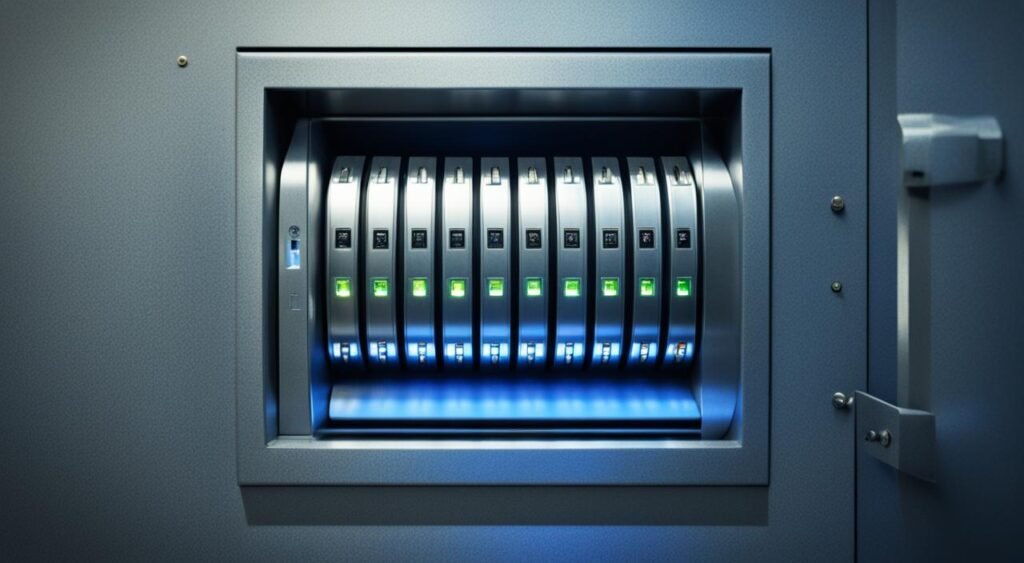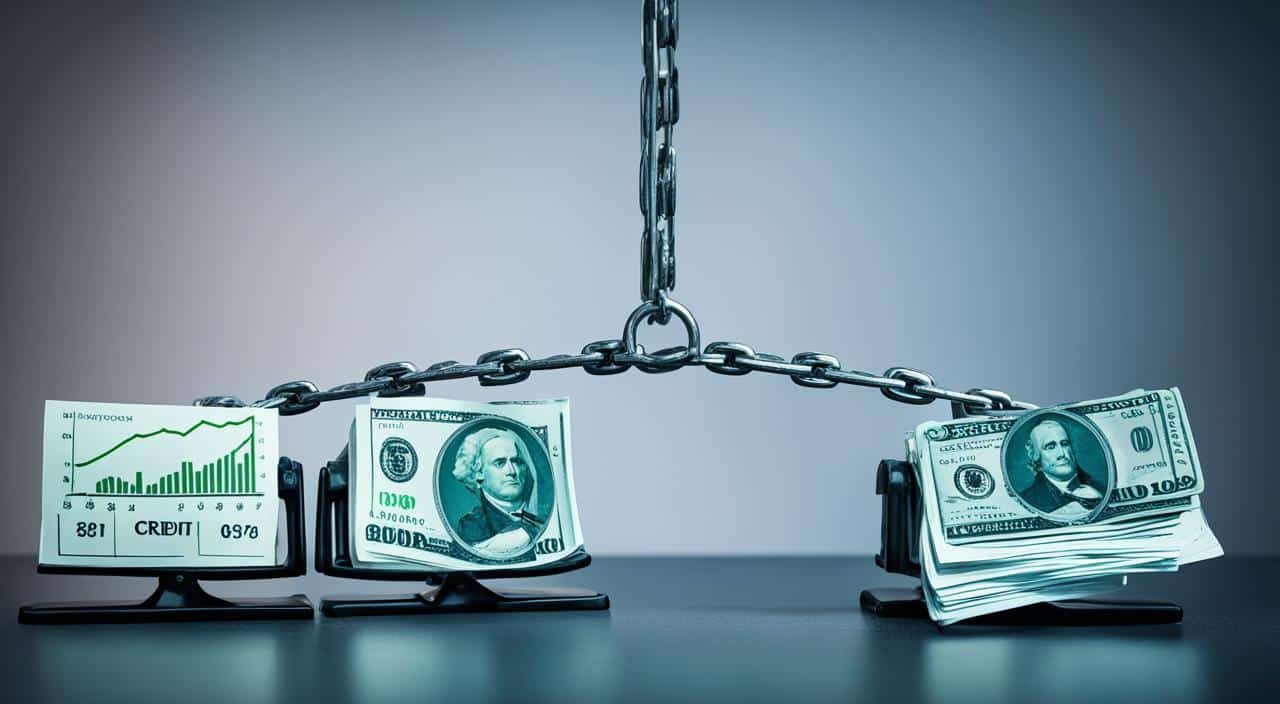Exploring The Impact Of Credit Risk On Financial Institutions
Credit risk is a big challenge for the banking world. It’s about the chance a borrower won’t pay their debts. This can cause the bank to lose money. Banks use their own money to take on their customers’ risks. They do this to earn more, but it can also mean they might lose more.
Banks aim to make as much profit as they can, especially the ones that are not owned by the government. When they take too much risk, it can hurt them. This not only puts the money of their customers and investors in danger but can also harm the economy. When loans are not paid back, it shows that the bank might be in trouble. This could lead to a larger financial crisis.
NPLs (non-performing loans) became a big topic after the financial crises. Many loans were not being paid back, affecting the world’s economies. This happened because financial systems around the globe are linked.
Key Takeaways
- Credit risk is a major challenge that jeopardizes the stability of the banking sector, resulting in losses for financial institutions.
- Banks take on increased risk to pursue profit maximization, but excessive and poorly managed risks can lead to losses that endanger the safety of depositors’ and investors’ funds.
- The accumulation of non-performing loans (NPLs) is considered a red flag and a potential sign of deeper troubles in the banking sector, associated with banking sector vulnerability and financial crisis occurrence.
- The issue of NPLs has been a dominant economic debate, with billions of dollars in NPLs recorded, affecting both developed and emerging economies due to global integrated financial systems.
- Effective credit risk management is crucial for banks to maintain their profitability and contribute to the overall stability of the financial system.
Introduction to Credit Risk
Credit risk is a big worry for financial groups. It’s when someone might not pay back what they owe. This could lead to big losses for the group. We’ll look at what credit risk is and why it’s so important for the banking world and the economy.
Definition of Credit Risk
Per the Basel Committee, credit risk means not getting a loan payment on time. This happens when the person who borrowed the money can’t pay. Then, the bank loses out. That’s the heart of credit risk.
Significance of Credit Risk in Financial Institutions
When lenders see more credit risk, they want a higher price for the risk they’re taking. Financing becomes more costly for banks. Also, a higher risk of people not paying back could lead to serious money problems for a bank. Offering new loans brings in money for banks, but it’s also risky. Credit risk is seen as the most serious danger for banks.
Financial groups need to handle credit risks well. Otherwise, it affects their profits. Good management helps banks stay healthy and profitable. It also ensures that money is used wisely, benefiting the entire economy.
Macroeconomic Determinants of Credit Risk
Macroeconomic conditions can heavily affect the amount of credit risk that financial institutions face. Things like how fast the economy is growing, the job market status, and inflation levels play a big role. They are seen as crucial factors in deciding credit risk.
Economic Growth and Credit Risk
There is an opposite link between economic growth and credit risk. When the economy grows more, borrowers are seen as more able to pay back money. This leads to fewer cases of people not paying their loans.
Unemployment Rate and Credit Risk
A higher unemployment rate is connected to more credit risk. This is because, with more people out of work, the chances of them not repaying loans go up.
Such a situation results in more bad debts.
Inflation and Credit Risk
Even inflation can up the credit risk game. How? Because it lowers the value of both what people earn and what they put up as loan guarantees. So, they find it harder to pay off their debts.
Bank-Specific Determinants of Credit Risk

Besides big economic trends, a bank’s own details can really change its credit risk. This includes how big it is, how well it’s funded, its success, and how effectively it runs. All these factors make a big difference in the risk a bank faces.
Bank Size and Credit Risk
The connection between a bank’s size and the risk it takes is not simple. Some research shows that bigger banks might lose less money on loans. They have advanced ways of handling risks and benefits from their size. Yet, other studies argue they might take bigger risks. They do this because they think if they fail, they will be saved because they are so big.
Bank Capitalization and Credit Risk
How much money a bank has in reserve, its capitalization, is very important in dealing with risk. Banks with more capital can handle loses from bad loans better. This makes them stronger against credit risk.
Bank Performance and Credit Risk
A bank’s good performance, shown by how much profit it makes, can mean less risk. Banks that do well financially tend to have fewer bad loans. They are likely managing their credit risks well.
Bank Operating Efficiency and Credit Risk
How well a bank uses its money, seen in its costs compared to its income, is linked to its risk. Banks that aren’t very efficient might have more loans that aren’t being paid back. This is because they might not check on their loans as well as they should.
Credit Risk

Non-performing loans (NPLs) show how much risk a bank takes on. These are loans where people stop paying or pay very late. More risk means more of these loans, which hurts how much a bank earns. This could even force a bank to lose money.
Non-Performing Loans as a Measure of Credit Risk
Non-performing loans tell us how much risk banks and financial groups are facing. When people don’t keep up with loan payments, it warns of potential financial losses. This shows why managing credit risk well is crucial.
Loan Loss Provisions and Credit Risk
Banks keep aside money called loan loss provisions for when loans might not get paid. If there’s more risk, they need more of this set-aside money. Keeping a big financial cushion is a way banks show they understand how risky their loans might be.
Industry-Specific Determinants of Credit Risk

Factors beyond just the economy and how banks are run can greatly influence credit risk. These include things like who owns the bank, how much it spreads its investments, and how much the banks compete with each other.
Bank Ownership Concentration and Credit Risk
When many banks in an area are owned by the state or are big multinational companies, they face less credit risk. This is because they can use advanced ways to manage risk, and they often get help from their governments. This help can lower their chances of losing money from bad loans.
Bank Diversification and Credit Risk
Having a variety of ways to make money, or different types of loans, doesn’t usually lower credit risk by a lot. While it might seem good to not have all your eggs in one basket, spreading out too much can create other problems. For example, keeping track of all these different activities can be really tough. This makes it harder to manage risk well.
Interbank Competition and Credit Risk
When banks compete a lot, it can go either way for credit risk. More competition often means banks might take bigger risks to try to get ahead. But it can also push them to be better at managing these risks. So, whether competition is good or bad for credit risk depends on how the banking market is set up.
Risk Management Strategies

Banks use different strategies to handle credit risk. They look closely at a borrower’s credit, set solid standards, mix up the types of loans they offer, and keep an eye on how the borrower’s financial health changes over time.
Credit Risk Assessment and Monitoring
When checking credit risk, banks do in-depth reviews of a borrower’s credit. They also assess if the borrower can pay back the loan and the value of what they use as security. It’s vital for banks to keep watching how well their borrowers are doing financially. This helps them catch any problems early, which can reduce the risk of big financial losses.
Loan Portfolio Diversification
Diversifying loan portfolios is key for banks. It means spreading out loans among different types of borrowers, industries, and places. This strategy helps reduce the risk of losing too much if one borrower or location has trouble repaying a loan.
Capital Adequacy and Credit Risk
Having enough capital is crucial for banks. This ensures they can handle losses from loan defaults. If a bank faces more credit risk, it must hold more capital. Yet, this can lower its profitability. So, managing credit risk well remains very important.
Regulatory Framework and Credit Risk

The Basel Accords are key in how banks manage their credit risks. They lay out rules for banks to keep enough money, handle their cash well, and make smart risk policies.
Basel Accords and Credit Risk Management
The Basel Accords tell banks to have enough money set aside for potential loan losses. Their goal is to make banks stable by making sure they can handle bad loans without major problems. Banks have to meet these money reserve rules and use strong credit risk plans to follow the Accords.
Stress Testing and Credit Risk
Stress testing is a big part of banking rules. It helps banks and their supervisors see how well they could take a hit, like in a bad economy or a crisis. By testing tough situations, banks can spot where they might struggle and fix it. So, stress tests keep the financial world stable by helping banks get ready for big credit risks.
Impact of Credit Risk on Financial Stability

Credit risk affects not just one bank but the whole financial system. If loans don’t get paid back, it hints at a possible big financial problem. This issue could shake the economy at its core.
Financial Crises and Credit Risk
Remember the subprime mortgage crisis and the European debt crisis? These were tough times. Lots of loans were not getting paid. This made banks weak, and the problem spread worldwide.
Systemic Risk and Credit Risk
Bad management of credit risk adds to a big risk for all banks, known as systemic risk. If one bank falls, it can make others fall too. This can hurt the whole banking system and risk the economy.
Also read: What Should I Do If My Credit Card Application Is Denied?
Conclusion
Credit risk is a big issue for banks. Non-performing loans show possible financial trouble. The causes of this risk include big picture factors, the bank’s own traits, and the industry as a whole.
To manage credit risk well, banks must look at it from many angles. They need sound assessments, mixing things up, and government rules. This helps banks stay strong and keeps the money system safe. Banks are key for an economy to grow. So, it’s vital that leaders and banks work together to handle credit risk well.
With strong plans and following the Basel Accords, banks can deal with credit risk better. This makes the money world safer for everyone. Good risk management helps economies grow in a healthy way. And it keeps people’s savings, investments, and other financial interests safer too.
FAQs
Q: What is credit risk?
A: Credit risk is the risk that a borrower may default on a loan or fail to meet their financial obligations.
Q: How is credit risk measured?
A: Credit risk is measured by assessing factors such as the borrower’s credit risk profile, credit rating, and the likelihood of default.
Q: What is a credit score?
A: A credit score is a numerical representation of a borrower’s creditworthiness, based on their credit history and repayment behavior.
Q: How do financial institutions manage credit risk?
A: Financial institutions manage credit risk by using credit risk models, analyzing concentration risk, and implementing risk mitigation strategies.
Q: What is concentration risk?
A: Concentration risk is the risk associated with a lender having a large exposure to a single borrower or group of borrowers.
Q: Why is it important to mitigate credit risk?
A: Mitigating credit risk helps financial institutions avoid potential losses from defaults and maintain a healthy credit portfolio.
Q: What is the role of collateral in credit risk management?
A: Collateral is an asset that a borrower pledges to a lender to secure a loan, reducing the lender’s credit risk in case of default.
Source Links
- https://cert-net.com/files/publications/conference/2017/AnthonyWoodandShaniseMcConneySHANWOOD2.pdf
- https://virtusinterpress.org/IMG/pdf/cbsrv4i3art2.pdf
- https://www.ncbi.nlm.nih.gov/pmc/articles/PMC8886134/
